
Our last (*sigh*) stop on this amazing Madagascar adventure was the small beach town of Ifaty, on the southwest coast, north of the relatively large and well-known city of Toliara. The main purpose of this location on our itinerary was to give us some time in the nearby spiny forest, a unique habitat for a unique set of plants and animals.
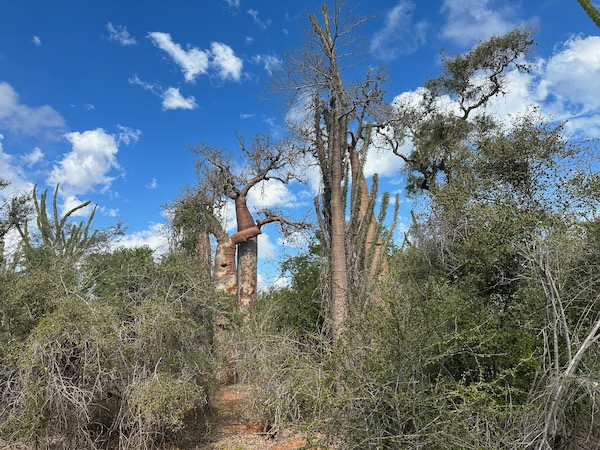
Much of the original spiny forest has been considerably degraded since people first arrived on Madagascar, but some well-preserved areas remain. They bring to mind southwestern US deserts full of cactus and mesquite and creosote, but of course all of the plants are different. None of them are actual cactuses, which are native only to the Americas. Also, a lot of the plants here are even weirder than cactuses.
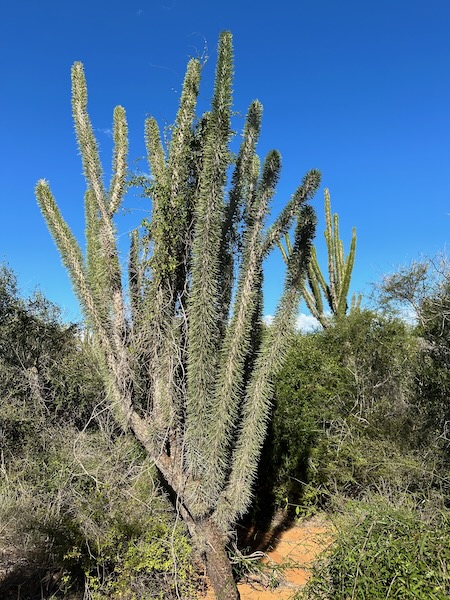
Madagascar Octopus Tree, Didiera madagascariensis

Pachypodium mikea
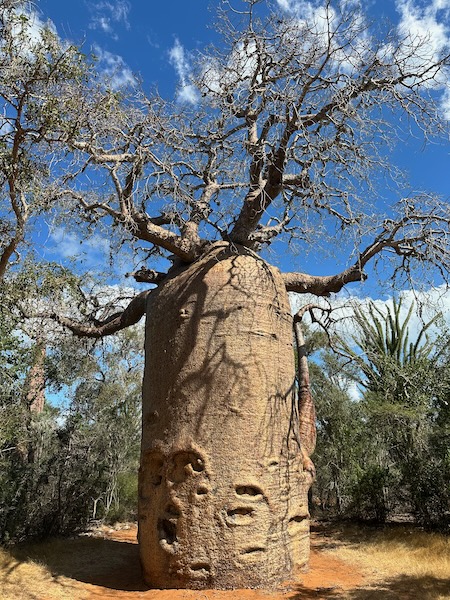
Fony Baobab, Adansonia rubrostipa

Frank, Ryan, Mike, me, Rainer, and José
This is the group that was still around at the end of our trip. I promise that no reptiles were involved in the absence of Mark and Aaron and Maholy.
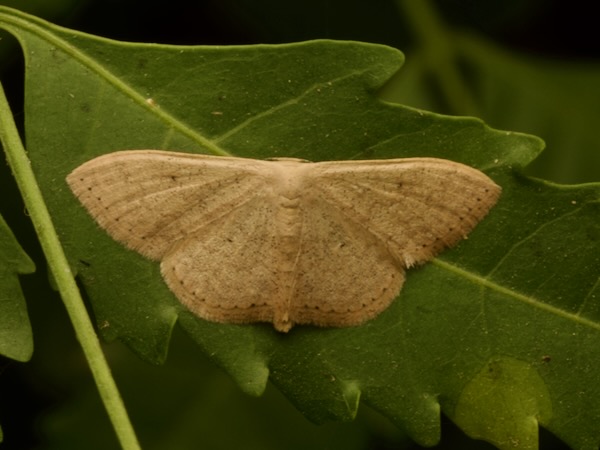
Scopula minorata
For some reason that I cannot explain I am a sucker for flat moths with this shape, which is typical of moths in the family Geometridae.

Island Policeman,
Coeliades pansa
I am also a sucker for any animal with a sufficiently cool name. And "Island Policeman" is certainly sufficiently cool.
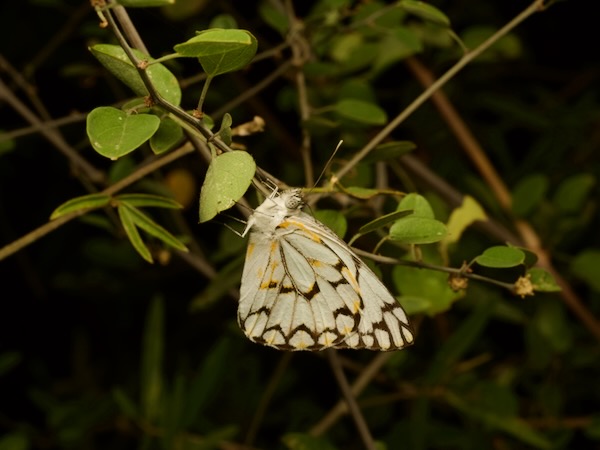
Belenois grandidieri
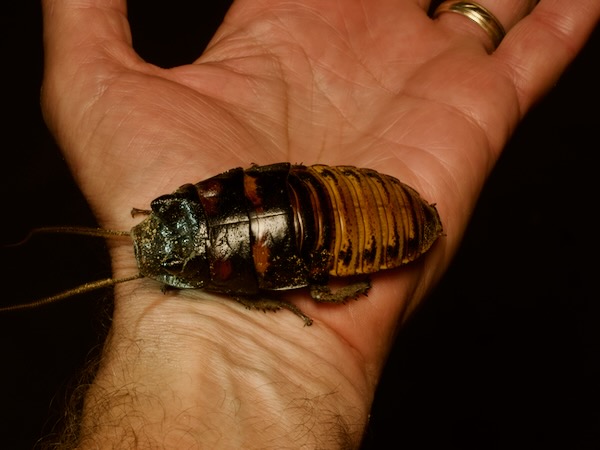
Madagascar Hissing Cockroach,
Gromphadorhina portentosa
Not a small cockroach. I have large hands.
Like Arboretum d'Antsokay, the spiny forest near Ifaty sported an excellent variety of orthopterans.
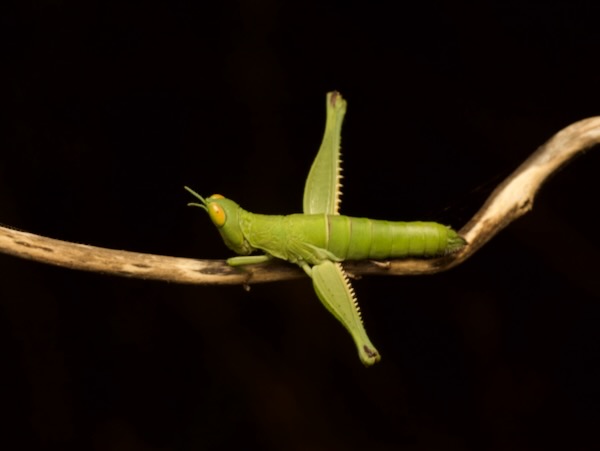
Bushhopper, family Euschmidtiidae

Rhadinacris schistocercoides
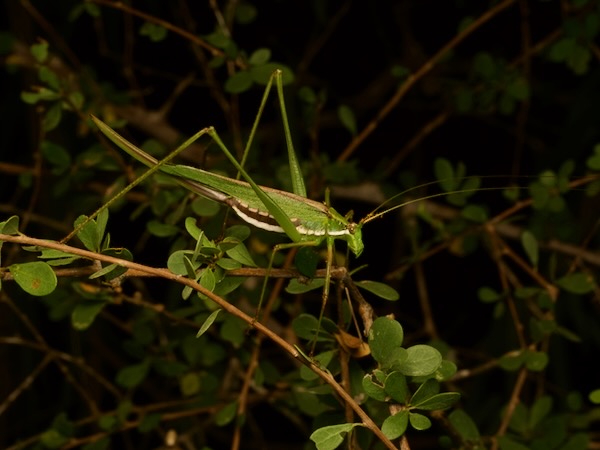
Katydid, family Tettigoniidae
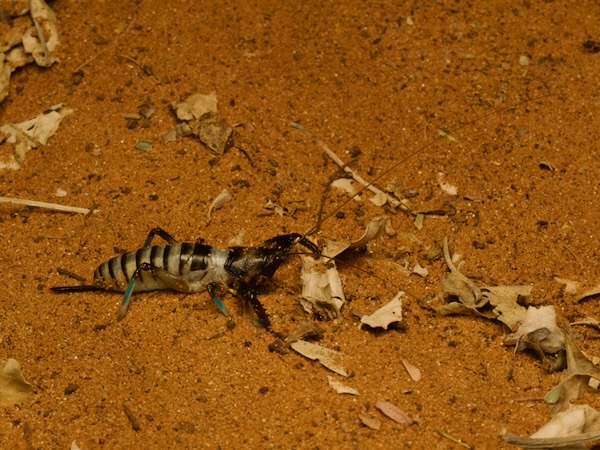
Colossopus grandidieri


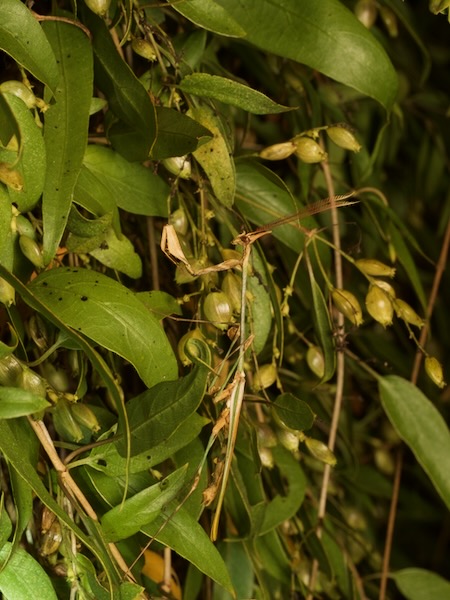
Chopardempusa neglecta
We only saw one type of mantis in this area, but it was a particularly weird-looking one,
and therefore awesome. We saw these three individuals, all at different development stages, and all within a few yards of each other.
Frank and José had come equipped with a good ultraviolet flashlight, which Mike wielded very successfully one night to spot several different types of scorpions.
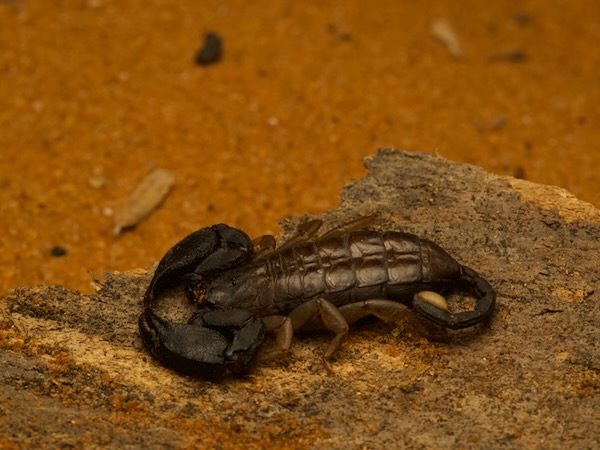
Opisthacanthus madagascariensis

Teruelius annulatus
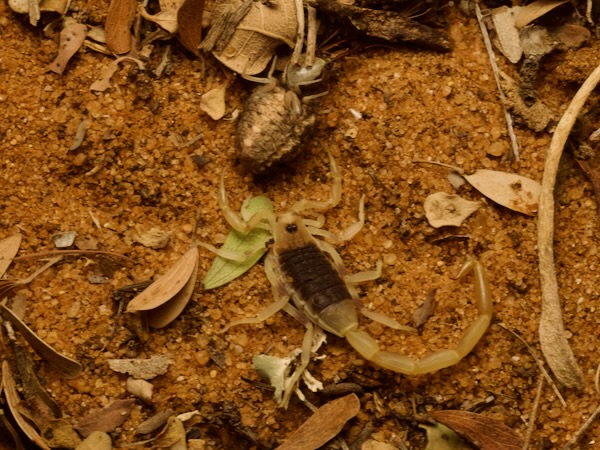
Neogrosphus griveaudi, with an ant lion larva
Many fine spiders called the spiny forest home.

Damastes sp

Ornamental Wandering Spider, Viridasius fasciatus
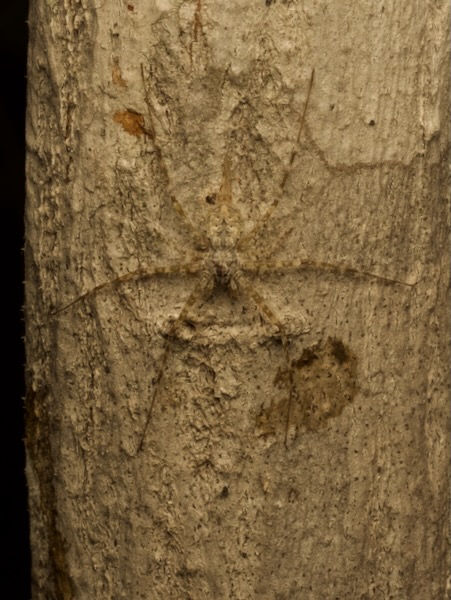

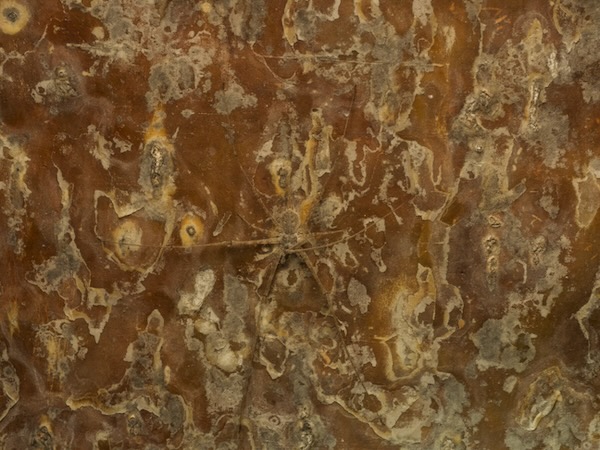
Two-tailed Spiders,
Hersilia sp
These long-leggedy spiders typically perched motionless on tree trunks, where they were very difficult to notice.

Scolopendra sp and Redleg Orbweaver,
Trichonephila inaurata
When we first saw this large centipede high in a web, we assumed that it had been caught there somehow by the spider. A closer look revealed that the centipede was chomping down on the spider, not the other way around. So I guess the centipede was able to climb down the threads of the web without getting stuck, and ambush the spider?
There were a reasonable number of birds around, but as usual I only got decent photos of the largest and slowest-moving ones.
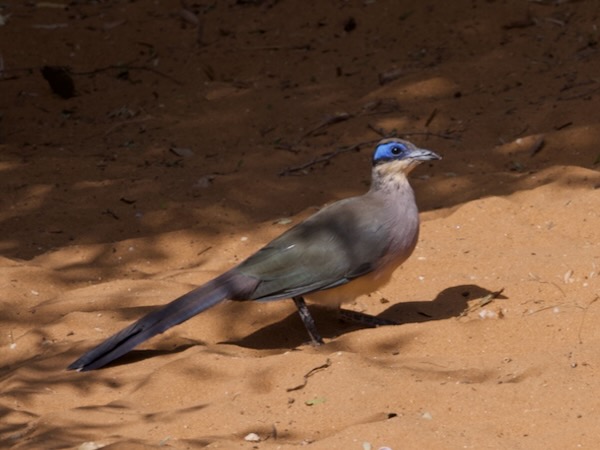
Red-capped Coua, Coua ruficeps

Lesser Vasa Parrot, Coracopsis nigra
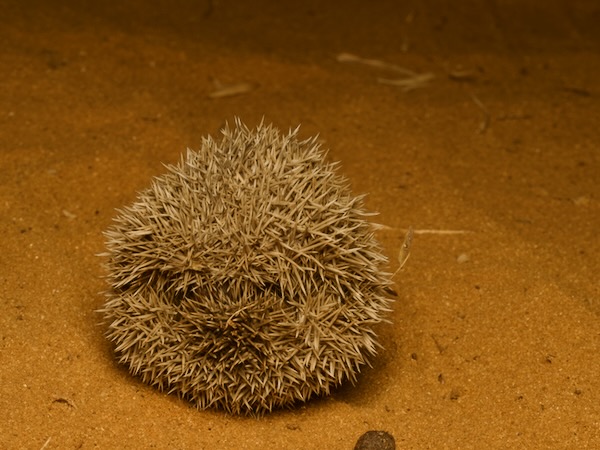
On our final night walk in Madagascar, one of the local guides pointed out this spiky ball in the sand. We were not familiar enough with the local sports to recognize the specialized equipment.

Lesser Hedgehog Tenrec,
Echinops telfairi
Imagine our surprise when, after ten minutes or so, it began to unroll.
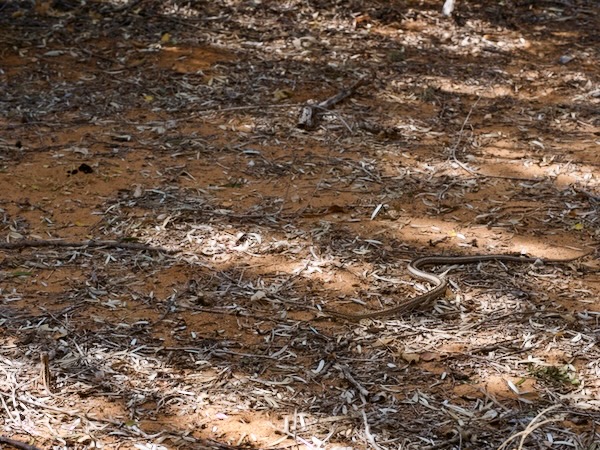
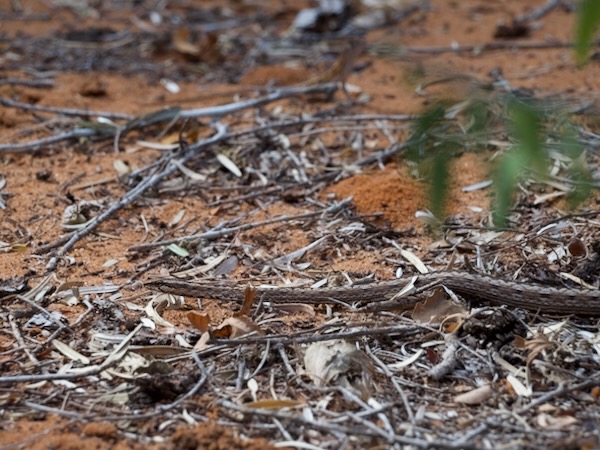
Pencil Snake,
Mimophis mahfalensis
We saw this snake moving in what seemed to be an oddly hesitant manner, before realizing that it was stalking a Madagascar Iguana (Chalarodon madagascariensis). The lizard can be seen in the bottom left corner in the first photo. The lizard was aware of the snake, but rather than running off (which would seem like the sensible thing to do), it repeatedly turned back towards the snake and moved a few steps closer. Apparently the lizard knew the striking range of the snake because it stayed far enough away that the snake never actually lunged at it, but instead gradually crept forward from time to time, before the lizard would run a short distance, turn back, and start the game anew. Eventually the snake grew weary and slithered away. Score one for the lizards!
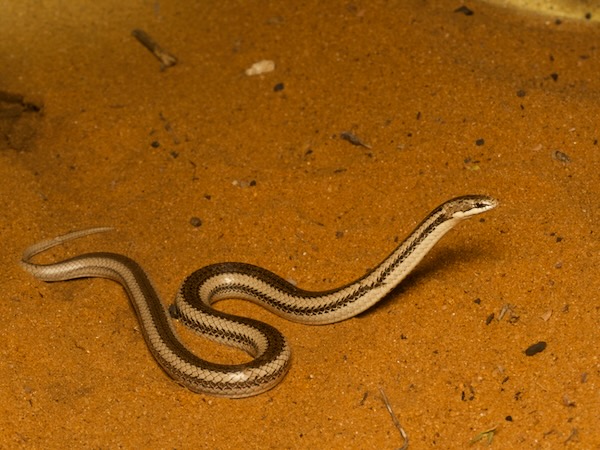
Toliara Smooth Snake,
Liophidium chabaudi
José spotted this snake swimming through the sand on one of our night walks. We managed to get it to pose momentarily above ground, but it wanted nothing more than to dive back in.

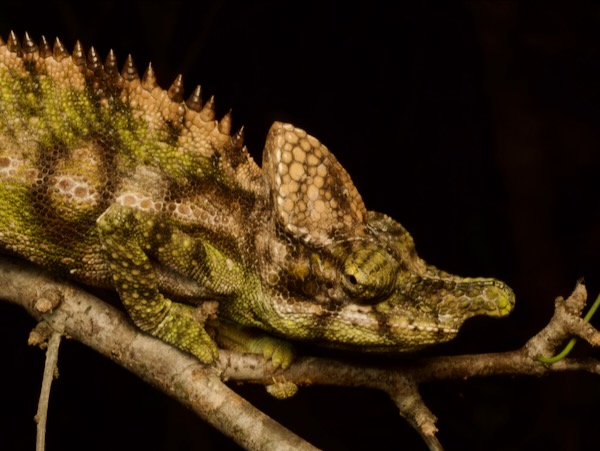
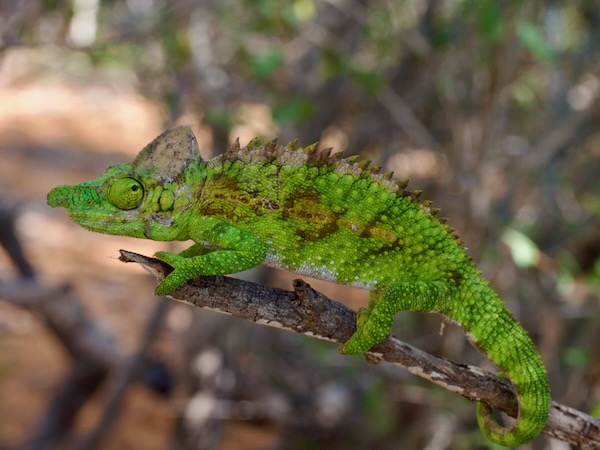
Antimena Chameleon,
Furcifer antimena
Furcifer antimena is one of the many chameleon species in Madagascar that are localized to a small area. This is why it's important to visit Madagascar over and over again, hitting at least some new locations each time.
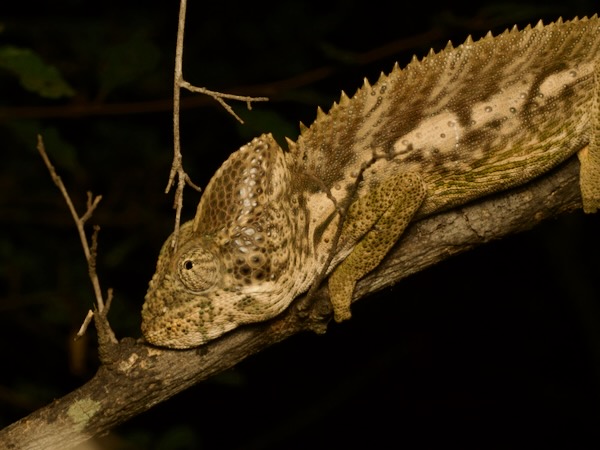
Spiny Chameleon,
Furcifer verrucosus
Furcifer verrucosus has a much larger range across southern Madagascar than Furcifer antimena, but its nose isn't nearly as silly.

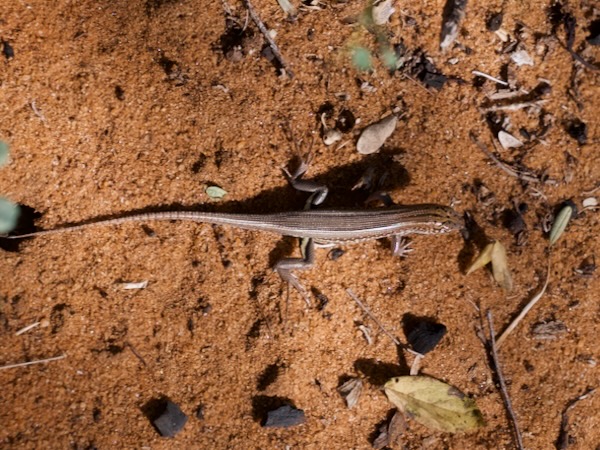
Peters' Keeled Cordylid,
Tracheloptychus petersi
The genus Tracheloptychus comprises only two species. We had seen the other one, T. madagascariensis, at Arboretum d'Antsokay, so we had the satisfaction of seeing all of the world's species of Tracheloptychus in a couple of days. Woo hoo!
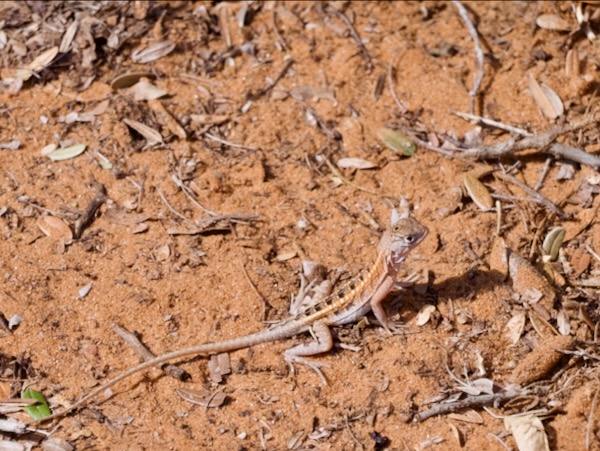
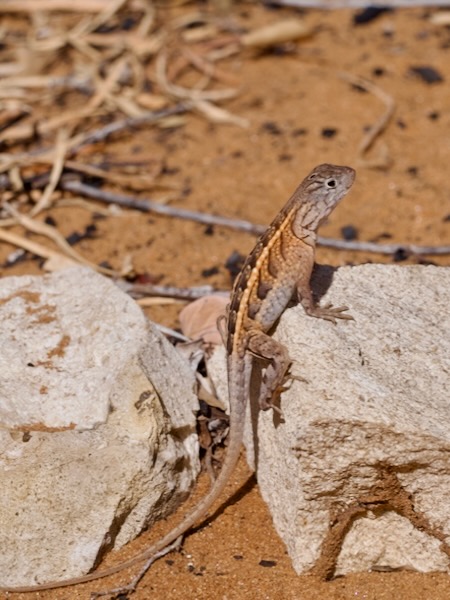

Madagascar Iguana,
Chalarodon madagascariensis
For every Tracheloptychus petersi basking and/or hunting in the sand, there were at least two Chalarodon madagascariensis. A lizard bonanza, to be sure.
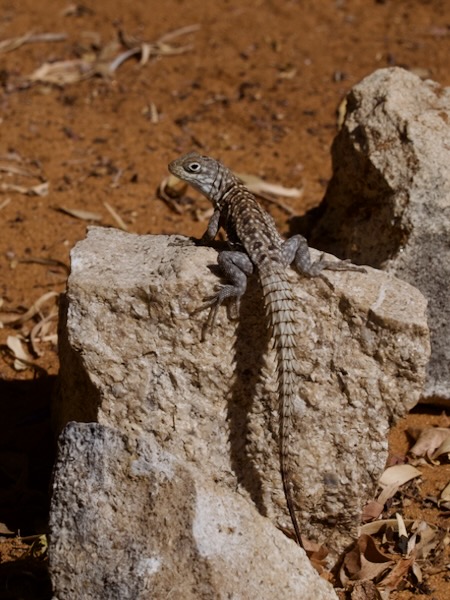
Merrem's Madagascar Swift,
Oplurus cyclurus
A handful of these more formidable-looking fellows joined the lizard jubilee in the spiny forest.
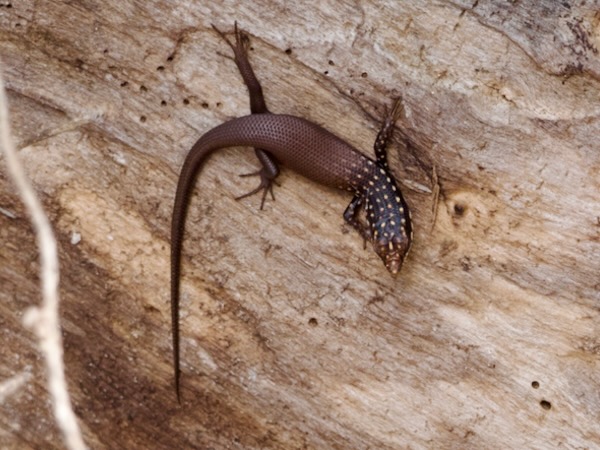
Gold-spotted Mabuya,
Trachylepis aureopunctatus
I saw one more of these beautiful skinks that we had also seen at Arboretum d'Antsokay.
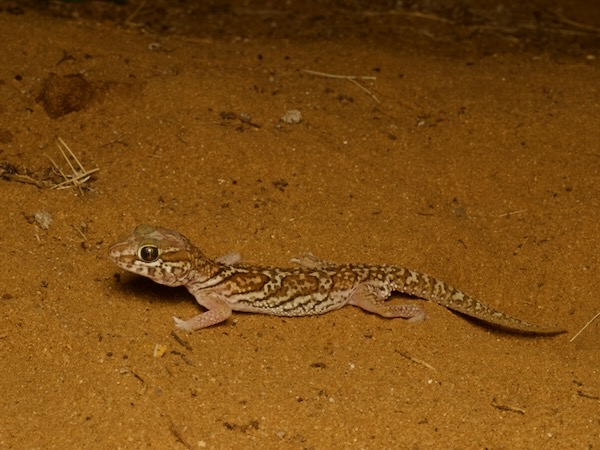
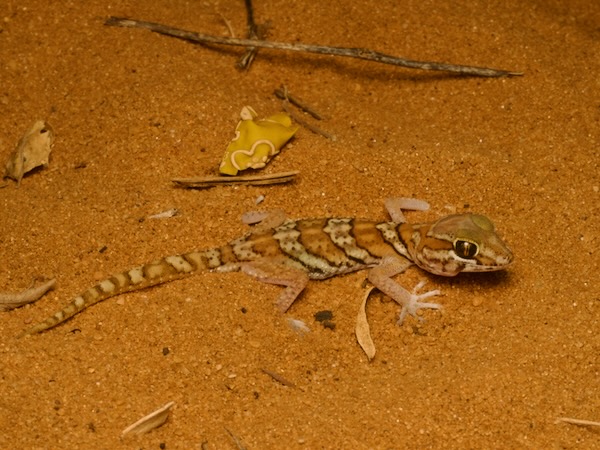
Madagascar Ground Gecko,
Paroedura picta
At night a few more of these big-headed geckos patrolled the sands.
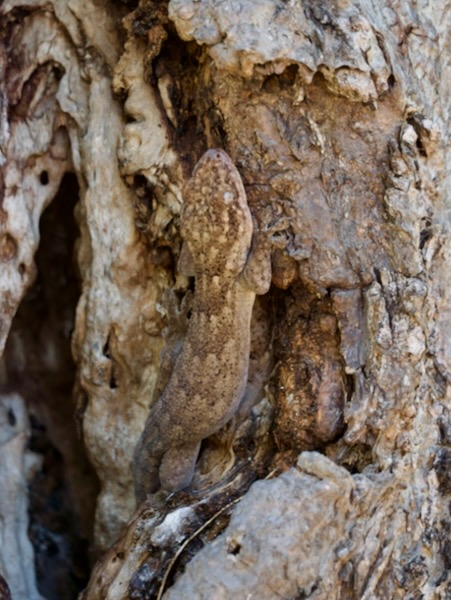
Tulear Velvet Gecko,
Blaesodactylus sakalava
Despite being nocturnal, these very large geckos are known to bask in the sun, typically in the trees where they spend most of their time. That's what this one seemed to be doing, at the entrance to a tree hole.

A fine looking Pachypodium mikea in the spiny forest. Let's look a little closer.
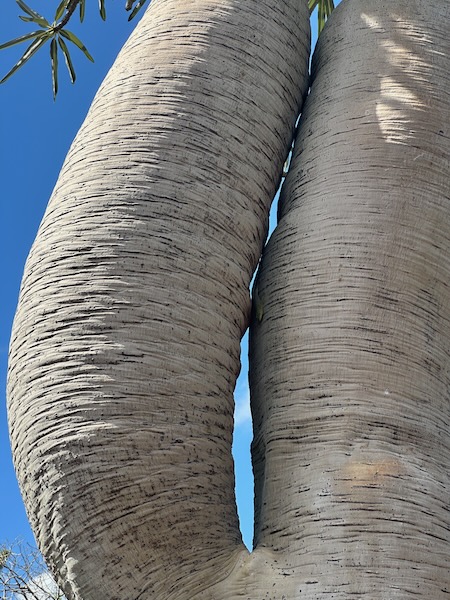
Hmm, is there something in the narrow gap between those two bulbous branches?
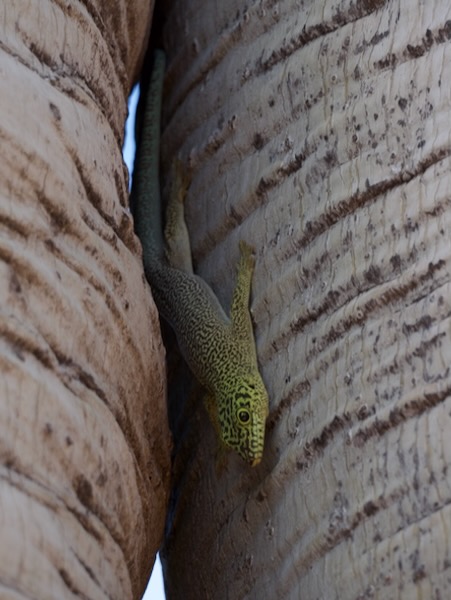
Banded Day Gecko,
Phelsuma standingi
Why yes there is: the most beautiful of all day geckos! This was the only individual of this species that I saw on an object that wasn't manmade; more on that coming right up.
We stayed at our beach lodge for two nights. During that time, we visited the nearby spiny forest reserves once per night and once per day. In the remaining hours we were either resting, eating, drinking, or wandering around the grounds looking for lizards.
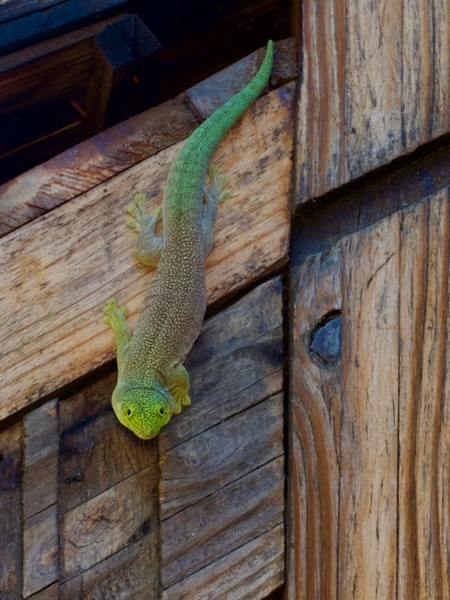
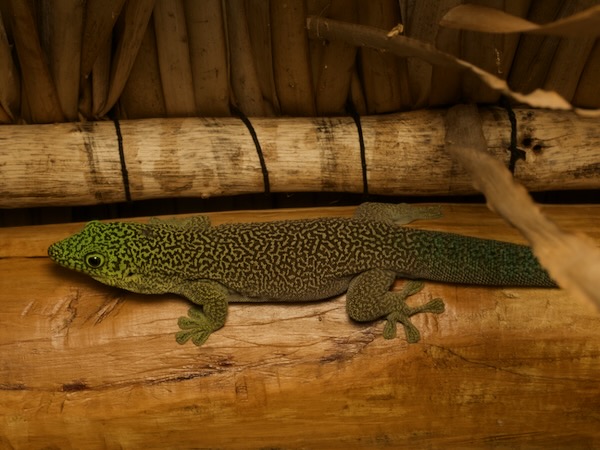
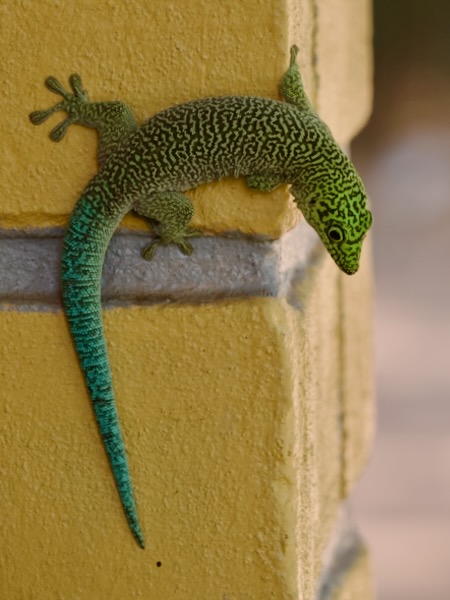
Banded Day Gecko,
Phelsuma standingi
The first lizards we encountered at the lodge were a bunch of those beautiful Phelsuma standingi, which ornamented the support poles and rafters of many a building. The bartenders in the open-air bar seemed surprised (or at least amused) by our fascination with these geckos, but I was surprised that every guest wasn't equally fascinated.



Thick Tail Gecko,
Phelsuma mutabilis
Tree trunks around the grounds served as hunting perches for well-camouflaged Phelsuma mutabilis.
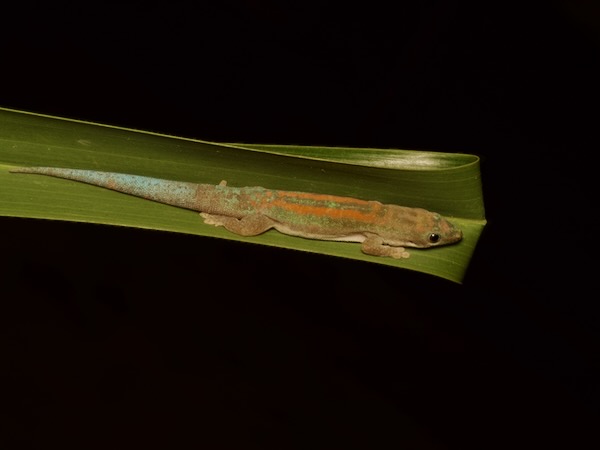
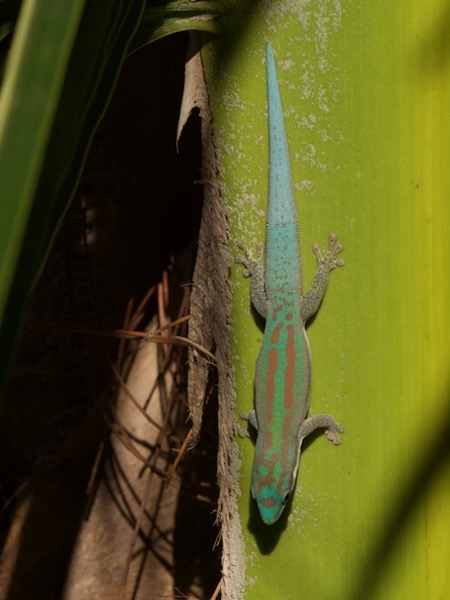
Modest Day Gecko,
Phelsuma modesta leiogaster
A couple of palm trees near the pool served as home to yet another good-looking Phelsuma species. If I looked like that I wouldn't be so modest.

Voeltzkow's Snake-eyed Skink,
Cryptoblepharus voeltzkowi
Frank dared venture out beyond the lodge grounds and onto the beach, past the extremely persistent local vendors, to inspect a rock outcropping that looked promising. His instincts were excellent and this fine skink was the result. This species lives on coastal rocks and descends into the intertidal zone to munch on small invertebrates.
At night, long after the rest of us had gone to sleep, José tirelessly searched around and under every rock and log in the area in a very successful hunt for some of the rarest lizards in this part of Madagascar. After considerable teasing that he might or might not have something interesting to show us, he blew us all away with this set of small but very excellent lizards.
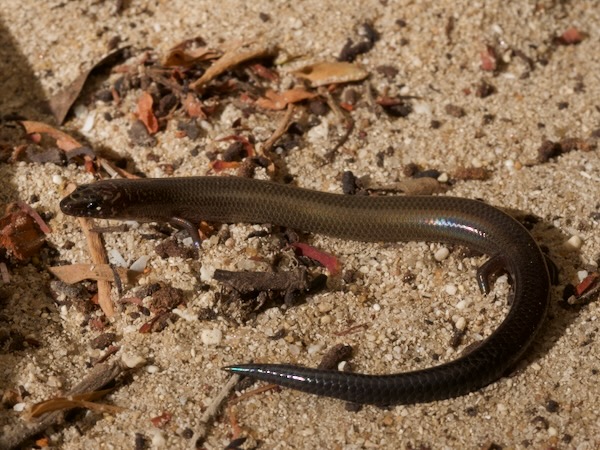
Grey Skink,
Flexiseps ornaticeps
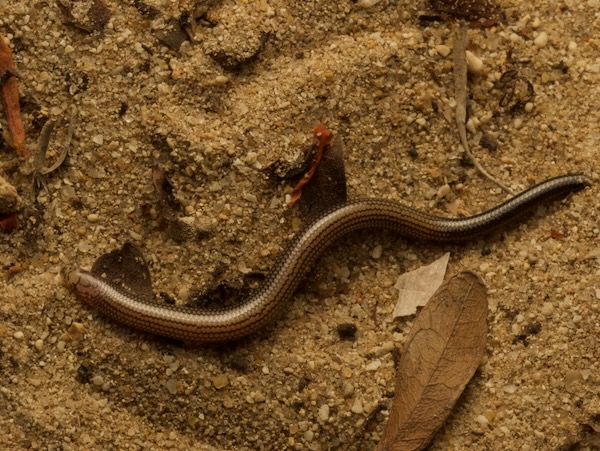
Striped Burrowing Skink,
Grandidierina lineata
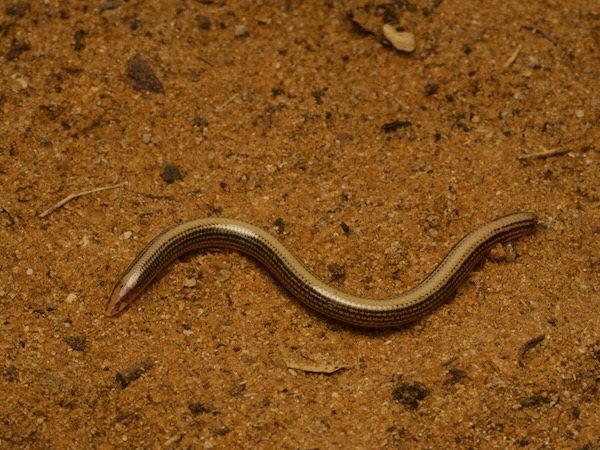
Redtail Burrowing Skink,
Grandidierina rubrocaudata
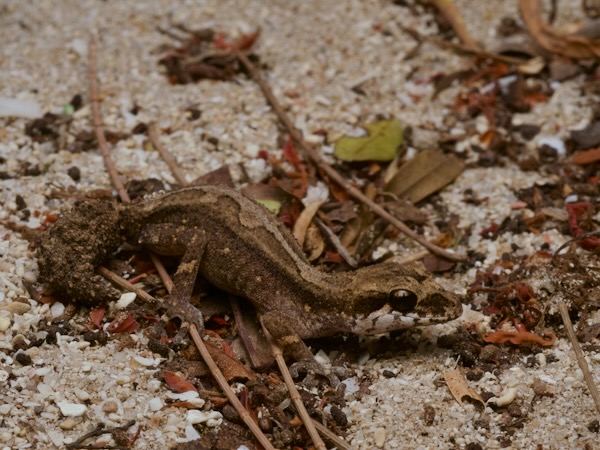
Grandidier's Madagascar Ground Gecko,
Paroedura androyensis
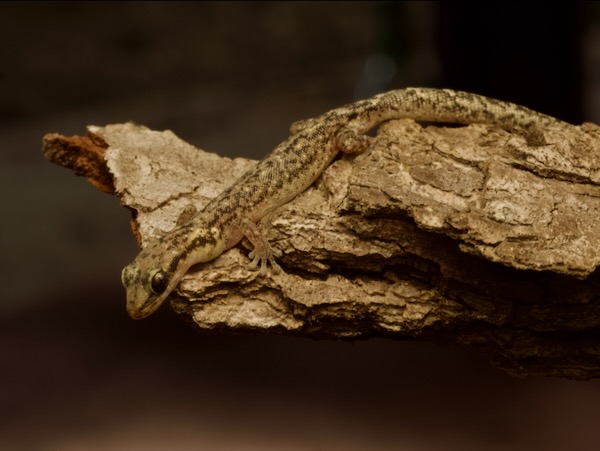
Toliara Ghost Gecko,
Matoatoa brevipes
And with that set of glorious lizards, our trip had come to an end, other than a short drive, a domestic flight, a very enjoyable final celebratory dinner, and a butt-numbing load of international plane travel. This was a fantastic adventure in one of my favorite places on Earth. I couldn't have asked for better people to lead this trip than José, Frank, and Rainer, who collectively knew everything that was worth knowing and could do anything that needed doing. To each of them I wish a lifetime of wildlife, travel, fun, and mofo gasy.
If you'd like to see a lot more of what I saw on this trip, you can check out the 3,000+ iNaturalist observations I made from this trip. Or to save yourself some time you could have a look at the illustrated and linked herp species list.
John Sullivan
December 2023































































